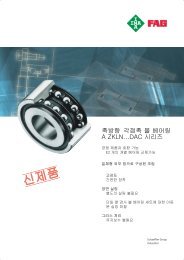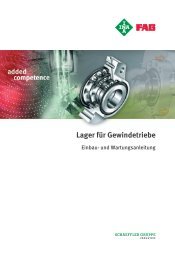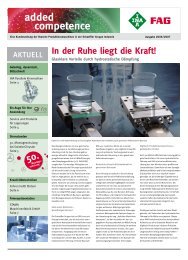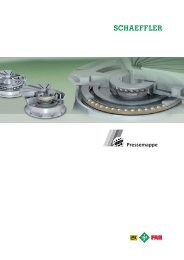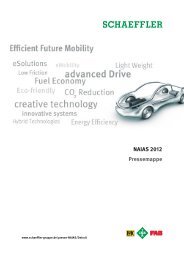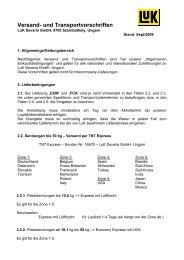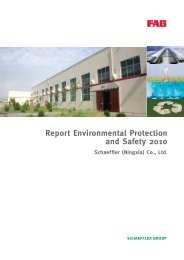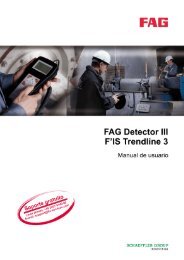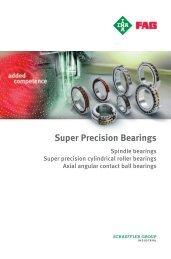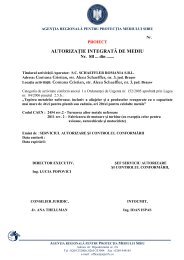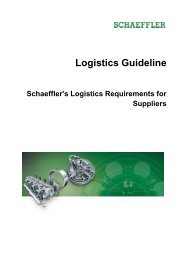26 - Schaeffler Group
26 - Schaeffler Group
26 - Schaeffler Group
Create successful ePaper yourself
Turn your PDF publications into a flip-book with our unique Google optimized e-Paper software.
<strong>26</strong> Chassis<br />
The development of an add-on control unit for volume<br />
producti on is a further focus of rear axle<br />
steering development. Figure 10 shows the concept<br />
being pursued by Schaeffl er for integrati ng<br />
the control unit arrangement in the OEM vehicle<br />
architecture.<br />
The low-level software is applied to the <strong>Schaeffler</strong><br />
control unit and specially matched to the<br />
BLDC motor developed by <strong>Schaeffler</strong>. For the<br />
high-level software of the vehicle controller, the<br />
customer can use both his/her own software<br />
and the vehicle controller developed by <strong>Schaeffler</strong>.<br />
This can be easily parameterized via a user<br />
interface and, therefore, quickly adapted to different<br />
customer requirements. The high-level<br />
software can be applied to the <strong>Schaeffler</strong> control<br />
unit and also to an existing customer control unit<br />
if suitable.<br />
Roll stabilizati on<br />
Passive stabilizers, usually in the form of torsion<br />
bar springs, are used to reduce sideways tilting<br />
of the body. These should not be selected with a<br />
high torsional rigidity<br />
because this will, otherwise,<br />
lead to a<br />
strong vertical movement<br />
of the body, socalled<br />
“duplicating”,<br />
when a vehicle is driving<br />
over obstacles (interference)<br />
on one<br />
side.<br />
To solve this conflict<br />
and also further reduce<br />
the roll angle,<br />
hydraulically actuated<br />
pivot actuators are<br />
used nowadays which<br />
twist a divided torsion<br />
bar depending<br />
on the transverse acceleration<br />
when a vehicle<br />
is travelling<br />
round bends, and<br />
thus noticeably reduce<br />
the tilting of the<br />
body and significantly<br />
equalize the wheel contact forces (Figure 11).<br />
When a vehicle is travelling straight ahead in<br />
the presence of interference on one side, the<br />
stabilizer must have an “open” effect which<br />
represents a gain in comfort in comparison with<br />
a passive stabilizer. Alternatively, tilting of the<br />
body can also be prevented by hydraulically adjustable<br />
suspension struts on the individual<br />
wheels (active body control ABC), which can<br />
eliminate the pitching movement when braking<br />
and accelerating in addition to the roll movement.<br />
Pneumatic systems are not suitable for<br />
this because of the high compressibility of the<br />
air.<br />
Requirements<br />
for roll stabilizati on<br />
The concept of only initiating the actuator in accordance<br />
with requirements and at the same<br />
time eliminating the hydraulic oil has led to an<br />
electric roll stabilizer consisting of an electric<br />
motor with ECU and a rotational gear with a high<br />
ratio and a compensation module (Figure 12).<br />
Without a compensation module to support the<br />
electric motor during rotary motion, it is not<br />
Figure 11 Functi on of roll stabilizati on (left without roll stabilizati on, right without)<br />
500 W<br />
from 12 V on-board<br />
power supply<br />
900 W<br />
- Vehicle weight: 1700 kg<br />
- Actua�on �me: 0,2 s<br />
- Bracing torque: 800 Nm<br />
- Max. current: 50 A<br />
Compensa�on?<br />
Figure 12 Roll stabilizati on requirements for an upper, mid-range vehicle<br />
possible to generate the bracing moment per<br />
axle specified in Figure 12 for a mid-range car or<br />
SUV with a 12 V system.<br />
The actuator comprises the electric motor with a<br />
flanged planetary gear and the compensation<br />
module which is switched in series. The two<br />
halves of the stabilizer are fixed to the ends of<br />
the pivot actuator by the flow of material. The<br />
system-related rigidity that is required for the<br />
stabilizer halves necessitates that they are further<br />
developed for electromechanical roll stabilization.<br />
It is not possible to give a detailed description<br />
of this topic due to the complexity.<br />
approx. 660 mm<br />
approx. 246 mm<br />
approx. 1100 mm<br />
Electric motor Planetary gear Compensa�on modul<br />
Figure 13 Actuator design with a compensati on<br />
module for roll stabilizati on<br />
The function of the compensation module has<br />
been thoroughly explained in the conference<br />
volume of the Symposium 2006 [11], therefore,<br />
the function is only briefly summarized here.<br />
The compensation module is a spring-energy<br />
store, which as a mechanical actuator supports<br />
and relieves the stress on the electric motor,<br />
and, therefore, extends the application limits to<br />
higher vehicle classes while applying the same<br />
load on the on-board power supply.<br />
On the right side of Figure 14, the bracing moment<br />
of the stabilizer is entered over the angle of<br />
rotati on (green line). The area created under it<br />
(sum of the green and blue areas) is the work<br />
which the actuator must apply. The work performed<br />
by the compensati on is equal to the area<br />
marked in blue. Therefore an electric motor<br />
switched in parallel must apply the work represented<br />
by the green area which leads to a signifi -<br />
cant improvement in the energy balance for the<br />
actuator.<br />
0<br />
Energy from compensa�on<br />
0 5 10 15<br />
Torsion angle in °<br />
Results and status<br />
of development work<br />
352 Schaeffl er SYMPOSIUM 2010<br />
Schaeffl er SYMPOSIUM 2010 353<br />
Torque in Nm<br />
600<br />
500<br />
400<br />
300<br />
200<br />
100<br />
Required torque<br />
Inner housing<br />
(le� half of stabilizer)<br />
Energy from electric motor<br />
Chassis<br />
FRad = f(φ,FSpring )<br />
TComp ~ FRad Compensa�on torque<br />
Figure 14 Design of the compensati on mechanism and<br />
benefi ts provided by compensati on<br />
As part of further development, <strong>Schaeffler</strong> has<br />
developed a universal control unit for roll stabilization<br />
for phase currents up to 120 A to demonstrate<br />
the function of the system from demonstration<br />
samples up to A samples in a vehicle<br />
(Figure 15).<br />
φ<br />
Outer housing<br />
(right half of stabilizer)<br />
F res<br />
<strong>26</strong><br />
<strong>26</strong>



